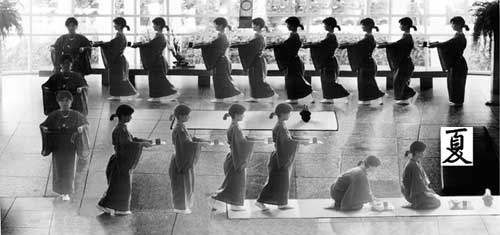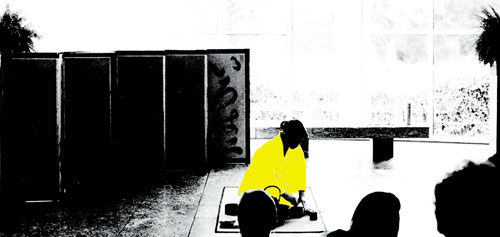Sadô (Tea Way) is an art deeply-rooted in Japanese living culture. During the Warring States period (from 1467 ca.100 years ) Tea Way has become a traditional pattern. Meister Rikyû (1522?-1591) sophisticated the Tea Way of life. The word вЂЕ›WabiвЂЕ› - to stay and work in incomplete beauty - is the most important for Tea Way.
The Tea Way is a life style. One can see a tea ceremony (a western word), but the original Japanese word вЂЕ›Cha (Tea) no TemaeвЂЕ› means вЂЕ›Tea´s Forward PointвЂЕ›. Each point forms a step on a proceeding line or way. One must always use the right and the left hand in a very specific manner. Therefore, Yumi Machiguchi would like to focus on this hand movement.
For Tea Way it is less important to have, for example, a nice Kimono as expected in the West, but to have a well-structured and composed communication in space and by gestures between the master and the guests. Yumi Machiguchi wants to try to work in the beautiful, modern Western architecture of the museum, which is a challenge, as it is very different from the style of a typical Japanese room and space for the Tea Way.


Between a Night and Morning, Photo-montage in camera, 25 x 93,5 cm
Transmedia Photography by Yumi Machiguchi
Robertson and McDaniel believe that the evolution of new media is one of the most important and influential processes as far as art after 1980 is concerned; next, they also emphasize deepening differentiation in artistic attitudes (artistic pluralism), connected - which is especially significant - with the growing awareness of diversity as the basic attribute of reality in all its manifestations; with the influence of theory on artistic practice; and with the interaction of art with visual culture of our everyday life. On the other hand, the key themes of contemporary art - themes that are a part of the title of the book quoted above - are, in the opinion of the authors, time, space, body, language, identity and spirituality.
Looking at the photographs by Yumi Machiguchi from the perspective of the above-mentioned concept, we can immediately notice their specific, intriguing and very individual way of partaking in the context of contemporary artistic practice. Machiguchi’s artistic attitude is far removed from the fascination with new technologies, especially those that change the photographic image into a digital simulacrum (although we should remember that the photographs from the Four Seasons series came into being with the considerable help of the computer). Machiguchi does not give in too much to the temptation of theoretization which leads artistic practice to cognitive, subversive and liberating procedures, or - which is an especially attractive case today - to some specific form of anthropological activity (and this approach seems closest to her artistic outlook). Furthermore, in Machiguchi’s case links with the visual culture of everyday life do not take on the form of interaction; they rather characterize the methods of acquiring material for the photographic worlds which she constructs. Only the awareness of diversity that can be seen both in the artistic choices she makes and in the structure of their results - i.e. the photographs - plays a truly important role in her creative work. Therefore, among the basic processes that Robertson and McDaniel name as influencing art after 1980, only one - the understanding of diversity - possesses meaningful form-creating power for the work of Yumi Machiguchi. But this power, however, is enormous and it encompasses the many dimensions her art.
But before we try to analyze Machiguchi’s art itself I suggest that we attempt to pin down the themes selected by the authors of Themes of Contemporary Art as the dominating motifs in the art of today. The result of this confrontation is different than before and extremely interesting. That is because it turns out that in this case - which differs from the attitude of the Japanese artist as set against the array of fundamental processes influencing art after 1980 - we can find a very meaningful compatibility here. The interest in the problems of time, space and identity as well as the spiritual dimension of her artistic attitude (and that makes four out of six themes pointed out by Robertson and McDaniel) is deeply rooted in her works; moreover, those problems become their characteristic features. Together they establish - in the context of the paradigm of diversity - the character of Yumi Machiguchi’s photographic works. Therefore, we must have a look at them before analyzing her art.
Time and space in Machiguchi’s photographs are aspects typified in a specific way. The series of photo-montages conducted within the camera - portraits and landscapes - take on the form of spatial/temporal palimpsests. The construction of those photographs reminds us that the artist in the early phase of her career was also interested in film which still occupies an important, though different place in her life. Thus Machiguchi’s imagination in effect progressed in a specifically cinematographic direction. However, images do not follow one another here and are not arranged in syntagmatic order, but they are connected in an extra-linear dimension. The times which those images represent, as well as the times that are constructed by them, evolve as if innerly, overlap and mix, creating fragmentary, hybrid and multi-dimensional forms. Scraps of events and fragments of scenes which themselves are unable to tell any story, become narratives from time to time thanks to the viewers and their readiness and willingness to tell stories. The stories we carry inside us tell themselves in the photographs of the Japanese artist discreetly, quietly and almost unnoticeably.
Her construction of space is quite similar. Space in Machiguchi’s works is also arranged in fragmentary and heterogenic orders that create a basically multi-spatial system in which repetition and transformation condition syntax. Space becomes temporalized to the same degree as time becomes spatialized, which only goes to show that time and space cannot be analyzed separately but only as elements of one spatial/temporal system.
The title of the exhibition: Time-Space-Movement, as well as the fact that most of the works presented here belong to the series of photo-montages within the camera, tell us that it is precisely this problem - the problem of space and time, in very different articulations - that moves to the foreground. On the other hand, the presence of the third element in the title - movement - emphasizes the transmedia character of the presented works. Movement in photography opens the perspective onto the cinema, whose form, as many theoreticians believed, could be simply described as photography plus movement. Thus it seems we can say that the basic features of the works presented at the exhibition are spatial/temporal hybridity and their transmedia character.
But not only time and space are hybridized in those works. The identity of people and spaces, as well as the identity of photography itself, as a medium and as artistic genre, becomes equally rich and varied here. All those ingredients and aspects of Yumi Machiguchi’s works combine into a transgressive, transmedia form: they are transsubstantial, forming a collage of the times, places and people. Hence we can now risk putting forward a more general hypothesis, namely that those two aspects - hybridity and transmedia - define Yumi Machiguchi’s work best.
This hypothesis is not weakened - on the contrary, it is strengthened - by the reflection on two other series of works presented at the exhibition. Photographs from the Four Seasons series intensify the hybridity and transmedia character of Machiguchi’s works since they bring new ingredients into the game. The photographic medium is related to performance art here, a very personal and intimate genre which in this case introduces also a social dimension as it immerses us also in a strange cultural context. Tea Way, a ritual that originated in the 15th century, is also a way of life, it determines both existential tension and ethical imperatives (Wabi). In an elaborate and refined way it combines a personal and social perspective. Transmedia nature and hybridity of material and structure, observed in the works of the previous series and preserved in the series we are currently analyzing, has been thus completed by a transcultural perspective. Machiguchi herself, who has lived in Europe for many years now, constructs a similar perspective in her life, although in this case the vectors probably point in different directions.
Moreover, this transcultural generic and media connection - of photography and performance - takes place in space defined by yet another kind of art: architecture. And it is by no means nameless, being the work of an American architect, Richard Meier. A hot tea ritual meets cold, abstract modernist architecture here, intensifying the hybrid and transmedia character of Machiguchi’s works and introducing the element of drama into them.
Those who have already seen the works from this series need not be reminded how elaborately the sphere of time is connected with the level of performance here. The idea of montage is evoked yet again in this case, though this time it is conducted with the help of computer technology and it leads to simultaneous structures built from heterogenic elements. In this case layers belonging to different phases of a single event - the tea ritual - have been combined within a single frame simultaneously to form its timeless image. This image also possesses its own narrative dimension as it becomes the story of the place and the role of the idea of perfection in an imperfect world.
The ritualistic character of the photographs from the Four Seasons series introduces also the problem of identity into play. I have already mentioned the presence of this element in the photographs of the Japanese artist when discussing her photo-montage portraits. Tea Way is a challenge for any individual who undertakes this ritual and in this way determines his/her social relations. It suggests the combination of two identities - the individual and the collective - within one image. The nonviolent meeting of the two could be described as the quintessence of the aforementioned ethical imperative, hidden in Tea Way.
The problem of identity is also present - for obvious reasons - in the third and last series of this exhibition: it contains self-portraits with Sho, a traditional Japanese musical instrument.
All those series present a coherent, although complex and multidimensional image of a hybrid world. Questions central forMachiguchi’s art, as she herself admits, are: "Who am I? Where am I? How did I get here?". These are the questions of a confused individual, a woman uncertain about things fundamental to her existence, who looks for the knowledge of herself and the world in which she is living.
Ryszard W. KluszczyЕ„ski

Natu (Summer) , Photo-montage in computer, 30 x 63,5 cm




Aki (Autumn) ,Photo-montage in computer, 40 x 18 cm
Tea Way

Exhibition organized as part of an
OPERATIONAL PROGRAMME
"Art Promotion"
Copyright ©2007 Galeria FF ЕЃDK, Yumi Machiguchi, Ryszard W. KluszczyЕ„ski